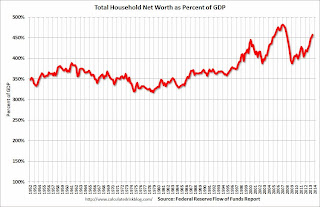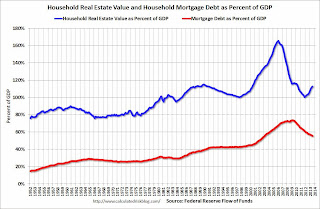by Calculated Risk on 12/09/2013 12:00:00 PM
Monday, December 09, 2013
Fed's Q3 Flow of Funds: Household Mortgage Debt increased slightly, First Mortgage Debt increase since Q1 2008
The Federal Reserve released the Q3 2013 Flow of Funds report today: Flow of Funds.
According to the Fed, household net worth increased in Q3 compared to Q2, and is at a new record. Net worth peaked at $69.1 trillion in Q3 2007, and then net worth fell to $55.7 trillion in Q1 2009 (a loss of $13.4 trillion). Household net worth was at $77.3 trillion in Q3 2013 (up $21.6 trillion from the trough in Q1 2009).
The Fed estimated that the value of household real estate increased to $19.0 trillion in Q3 2013. The value of household real estate is still $3.6 trillion below the peak in early 2006.
 Click on graph for larger image.
Click on graph for larger image.
This is the Households and Nonprofit net worth as a percent of GDP. Although household net worth is at a record high, as a percent of GDP it is still below the peaks in 2000 (stock bubble) and 2006 (housing bubble).
This includes real estate and financial assets (stocks, bonds, pension reserves, deposits, etc) net of liabilities (mostly mortgages). Note that this does NOT include public debt obligations.
This ratio was increasing gradually since the mid-70s, and then we saw the stock market and housing bubbles. The ratio has been trending up and increased again in Q3 with both stock and real estate prices increasing.
 This graph shows homeowner percent equity since 1952.
This graph shows homeowner percent equity since 1952.
Household percent equity (as measured by the Fed) collapsed when house prices fell sharply in 2007 and 2008.
In Q3 2013, household percent equity (of household real estate) was at 50.7% - up from Q2, and the highest since Q2 2007. This was because of both an increase in house prices in Q3 (the Fed uses CoreLogic) and a reduction in mortgage debt.
Note: about 30.3% of owner occupied households had no mortgage debt as of April 2010. So the approximately 52+ million households with mortgages have far less than 50.7% equity - and millions have negative equity.
 The third graph shows household real estate assets and mortgage debt as a percent of GDP.
The third graph shows household real estate assets and mortgage debt as a percent of GDP.
Mortgage debt increased by $10.0 billion in Q3. (Still declined as percent of GDP). This is the first increase in mortgage debt since Q1 2008.
Mortgage debt has now declined by $1.32 trillion from the peak. Studies suggest most of the decline in debt has been because of foreclosures (or short sales), but some of the decline is from homeowners paying down debt (sometimes so they can refinance at better rates).
The value of real estate, as a percent of GDP, was up in Q3 (as house prices increased), but still close to the average of the last 30 years (excluding bubble). However household mortgage debt, as a percent of GDP, is still historically high, suggesting a little more deleveraging ahead for certain households.


